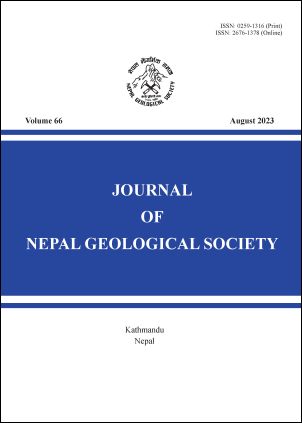Failure mechanism of large-scale landslide in the central Nepal Himalaya
DOI:
https://doi.org/10.3126/jngs.v66i01.57921Keywords:
Large-scale landslide, failure mechanism, modelling, central NepalAbstract
The geomorphological and geological characteristics of central Nepal reflect the dynamic nature of tectonic and mass movement processes that lead to the occurrence of large-scale landslides (LSLs). The mechanism of the LSL failure process is not well understood due to the different deformation stages controlled by geological structures and causative/ triggering factors. Regional tectonic structures and local rock mass characteristics play a vital role in the formation of LSLs. Engineering geological characterization was performed to evaluate the rock/soil properties, and the associated state of danger (cracks, seepage, etc.). The rock mass rating (RMR) and geological strength index (GSI) methods were used to estimate rock mass quality and strength parameters. The estimated strength parameters together with laboratory test data were used to set up a two-dimensional (2D) landslide surface to simulate the failure scenarios. The simulation of landslide models was iterated under different loading conditions by incorporating geological heterogeneities. The results have demonstrated that the movement of the slope was affected by different stress conditions over time, which were verified using spatiotemporal landslide data. The landslide exhibited a three-stage failure mechanism with the development of tension-induced cracking at the rear and shearing failure of the critical locking section in the middle section. The tension shear and joint-step-path rupture along joint surfaces occurred during different stages of the landslide failure processes. The simulated results showed that the genetic development of LSL is mainly attributed to the geological structures and sudden changes in stress conditions. Thus, the research outcomes can be illustrative to evaluate the role of geological discontinuities, geotechnical parameters and triggering effects by the numerical simulation techniques for the failure mechanism of LSLs.
Downloads
Downloads
Published
How to Cite
Issue
Section
License
© Nepal Geological Society




